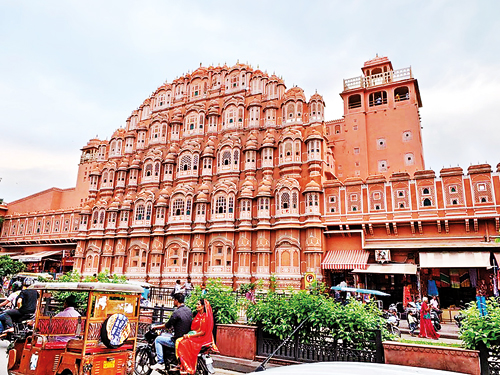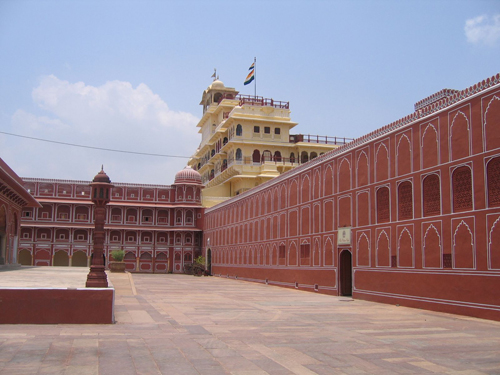The Pink City unveils its glory

Hawa Mahal, Jaipur
Visiting Delhi recently, I took the opportunity to fly to the Pink City, as Jaipur, Rajasthan’s colourful capital is known. Jaipur forms part of the Golden Triangle of Indian tourism with Delhi and Agra. By car the journey from Delhi is six hours. King Jai Singh II, renowned as a warrior and astronomer built Jaipur as a planned city and his name is given to the city. His great grandfather Man Singh I established the palace.
The royal family was believed to be descendants of Lord Rama and the palace is now the home of the present young Maharaja and his family. The princely states of India were abolished in 1971 and the titles are honorific. Quite a few palaces around India are hotels and some of the royals are involved politically.
“A Princess Remembers” the book by the beautiful Gayatri Devi, formerly of Cooch Behar, who was Jai Singh’s third wife makes interesting reading. She and her husband, also a famous polo player were very much on the international stage. The present Maharaja’s grandfather was known as ‘Bubbles’, as so much champagne was consumed when Jai’s eldest son was born.
The Pink City’s colour is actually Gerua (or ochre), in which its buildings were painted for the visit of the Prince of Wales in 1905-06. The streets of Jaipur are always bustling and there is shopping aplenty but no visitor can leave without taking in some of the city’s main attractions:
Amber Fort
King of Kakildev, who was the King of Amrish, built the Amber Fort in the 11th century. A freedom wall of 12 km was built surrounding the fort situated on a hill with watchtowers for the soldiers, who beat their drums if an enemy was sighted. The fort is 11 km out of Jaipur and is one of the city’s main tourist attractions. Maharaja Man Singh, a Rajput who led the Mughal ruler, Akbar’s army rebuilt the fort in 1592 and for a period it served as the capital of the state. It is now a UNESCO world heritage site.
Made out of sandstone and marble, the complex houses a series of palaces, halls and gardens. The main courtyard, Jaleb Chowk has two gates – the sun and moon gate. To the left were the stables for the horses and a balcony overlooking the court was for the drummers.
The edifice is a mix of Hindu and Muslim architecture with beautifully painted vegetable dye flowers in the Islamic style on the walls with heads of elephants flanking the stairs. On a raised dais was the King’s public audience hall with pillars.
The drainage system to gather the rainwater and cool the palace holds underground water tanks.
Within the Amber Fort is a small white marble temple dedicated to Goddess Kali, named the Shila temple; the temple of the Royal family. At the top of the entrance portal is a beautiful coral Ganesh statue.
King Man Singh I’s quarters were upstairs and below were 12 apartments for his wives, (whom he chose to beckon without the knowledge of the others.) The king had 27 children. Chandrawathi was his favourite wife. Eunuchs guarded the ladies’ quarters.
Exquisite work with Belgian glass is the ‘Hall of Mirrors’ for the King’s private audience with two entrances on either side for the Queens. On the opposite side of the garden is the summer palace where the King used to relax with the ladies of the court. Look out for the small chariot or palanquin on wheels, which used to transport the Queen. The ladies of the court wore ornate clothes and jewellery, which restricted walking.
At the foot of the citadel is a temple dedicated to Lord Krishna built in the 16th century after the Chittor war.
The sandstone Jaigar Fort also known as ‘Victory Fort’ built by Mirja Jayasingh in 1726 has the largest cannon ‘Jaivana Cannon’and the armoury. On the Hill of Eagles, 500 feet above sea level visitors are treated to panoramic views of the surrounding countryside. The views are equally wonderful from its latticed windows, but from outside no glimpse of the interior is visible.
City Palace
Sawai Jai Singh II originally built the City Palace in 1727; at the same time the city of Jaipur was established due to a rise in the population and water shortages in Amber, his former seat. Until 1949 the City Palace was the ceremonial seat of the Maharaja used for religious and state occasions.A Bengali architect, who worked as an accounts clerk for the royals, but was later promoted as chief architect, designed the complex.

The Pink Palace
Considered a fine example of Rajasthani and Mughal architecture combined, the palace has separate entrances for the Royal family and for other visitors, which leads one to the public audience hall, a pavilion of marble with a series of cusped arches. Within the large courtyard is the Sarvato Bhadra with four rooms for enclosed meetings at the four corners. Here the ruler could hold court with his senior officials. It has also been used for rituals, royal festivals and the coronation of the ruler. To a side are two huge sterling silver vessels, which were used to carry water from the Ganges for the Maharaja’s use when he went to the UK for the coronation of King Edward the VII.
The inner smaller courtyard has four entrances depicting the four seasons. These are the Peacock, Lotus, Waves and the Rose Gates for autumn, summer, spring and winter each dedicated to a goddess.
The seven storey (seven being an auspicious number) Chandra Mahal is the oldest building in the palace. Some of the areas are not open to the public however; the smaller audience hall with its Belgian glass and starry ceiling when the lights are switched off and a candle lit were exquisite.
Jantar Mahal
To the east of Chandra Mahal and viewed from the palace is Jantar Mantar, one of the five observatories built by Sawai Jai Singh that has a set of 20 fixed instruments, some believed to be the largest in their particular categories.
Hawa Mahal
Sawai Pratap Singh built the Hawa Mahal or the ‘Palace of the Winds’ in the 18th century. Made of red and pink sandstone, the façade is unique with five storeys of 953 windows with latticed screens, through which the ladies of the court who had to maintain strict purdah could look down upon the happenings in the bazaar below. It is modelled in the shape of a crown of Lord Krishna and its exquisitely ornate façade is said to resemble a honeycomb.
The Rajputs’ great heritage is clearly seen in all these sites – palaces and forts that make a trip to Jaipur memorable for any visitor.


